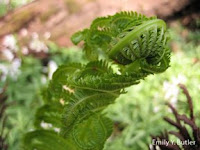If you're interested in collecting Matteuccia fiddleheads yourself, it's very important that you be able to recognize it. There are several other ferns that look similar to Matteucia, including the relatively common Cinnamon Fern, Osmundastrum cinnamomea. However, most ferns are packed with secondary compounds and potential carcinogens, and Matteuccia is the only one deemed acceptable for human consumption.
The pictures above may be helpful in finding this fern. Matteuccia has separate sterile and fertile fronds (known as dimorphic fronds), with the brown fertile ones often emerging first in spring. It is from these that the species gets its common name, Ostrich fern, since they resemble the plumes of an ostrich's tail. Another important identifying character is the groove that runs down the rachis; the fiddleheads and lower part of the rachis will also be covered in golden to brownish scales. If you want to rustle up some fiddleheads yourself, please consult a fern field guide, naturalist, or other expert before consuming anything you collect. Remember, many ferns may contain carcinogens! Also, don't collect every last fiddlehead from one plant, or it won't be able to persist through to the next season.
Last but not least, if you do acquire fiddleheads for your table, let me know how you cook them! Leave a note using the comments button, or email me. I would be very interested to know what works, and perhaps more importantly, what doesn't. I'll leave you with a tasty-sounding recipe I found at the University of Maine Cooperative Extension's website:
Fiddlehead Dijon
1-1/2 pounds fresh fiddleheads
1 tablespoon cornstarch
1 cup nonfat buttermilk
2 teaspoon Dijon mustard
3/4 teaspoon lemon juice
1/2 teaspoon dried tarragon
1/4 teaspoon pepper
Clean and prepare fiddleheads. Remove scales and wash thoroughly. Place fiddleheads in a vegetable steamer over boiling water. Cover and steam 20 minutes or until crisp-tender. Set aside and keep warm.
Combine cornstarch and buttermilk in a small saucepan; stir well. Cook over medium heat until thickened and bubbly, stirring constantly. Remove from heat; stir in mustard, lemon juice, tarragon and pepper.
Arrange fiddleheads on a serving platter. Spoon sauce over fiddleheads. Serve immediately. Yield: 6 servings.
Bon appetit!
















